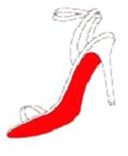Background
You may recall that we have been following the progress of an invalidity action against Louboutin's 2010 Benelux registration for "the colour red (Pantone 18 1663TP) applied to the sole of a shoe as shown (the contour of the shoe is not part of the trade mark but is intended to show the positioning of the mark)":


- Back in July 2017, we blogged here on the Advocate General's Opinion regarding the colour red applied to the soles of the shoes.
- In October 2017, we reported here that the Court of Justice of the European Union ("CJEU") had taken the unusual step of re-opening the oral case and re-assigning it to the Grand Chamber.
- In February 2018, we blogged here on the AG's Further Opinion.
Today (12 June 2018), the CJEU issued its decision (Case C-163/16), ruling that a mark consisting of a colour applied to the sole of a shoe is NOT covered by the prohibition of the registration of shapes, since the mark does not consist "exclusively of a shape".
History
Louboutin commenced proceedings against Van Haren Schoenen BV ("Van Haren") (a Dutch shoe retailer) due to Van Haren's sale of shoes with red soles. The initial judgment was in Louboutin's favour, so Van Haren challenged the validity of Louboutin's trade mark, under Article 3(1)(e)(iii) of the Trade Marks Directive (2008/95/EC), which prevents registration of any sign which consists "exclusively of… the shape which gives substantial value to the goods". Van Haren argued that the colour red conforms to the shape of the shoes and gives them substantial value.
The Hague District Court referred to the CJEU for a preliminary ruling, asking whether the concept of ‘shape’ is limited to three-dimensional properties of the goods, such as their contours, measurements and volume, or whether it includes other (non three-dimensional) properties of the goods, such as their colour.
Advocate General's Opinion and further Opinion
In his first Opinion, AG Szpunar was of the view that there is a distinction between colour marks per se (which would not fall within the scope of Article 3(1)(e)), and marks where a colour was integrated into the shape of the goods (which did fall within the scope of Article 3(1)(e)).
In his further Opinion, AG Szpunar was of the view that Louboutin's trade mark was one which would potentially be caught by the prohibition contained in Article 3(1)(e), stating in his Further Opinion that, "Having heard the submissions of the interested parties at the hearing on 14 November 2017, I am even less inclined to classify the mark at issue as one consisting of a colour per se".
CJEU ruling
In today's ruling, the CJEU took the unusual step of departing from the AG's opinion and ruled that the mark in question could not fall foul of Article 3(1)(e) since it does not consist exclusively of a shape.
As the 2008 Trade Marks Directive provides no definition of the concept of 'shape', the meaning must be determined by considering its usual meaning in everyday language. The CJEU pointed out that it did not follow from the usual meaning of 'shape' that a colour per se, without an outline, may constitute a 'shape'. In addition, while the shape of the product (or of a part of the product) plays a role in creating an outline for the colour, it cannot be held that a sign consists of that shape in a case where the registration of the mark did not seek to protect that shape but sought solely to protect the application of a colour to a specific part of that product.
Louboutin's trade mark does not relate to a specific shape of sole for high-heeled shoes, since the written description of that mark specifically states that the contour of the shoe does not form part of the mark and is intended purely to show the positioning of the red colour covered by the registration.
In addition, the main element of Louboutin's trade mark is a particular red colour which can be understood by reference to an internationally recognised identification code. The CJEU therefore considered that such a colour trade mark could not be regarded as consisting 'exclusively' of a shape.
Comment
The CJEU's decision is welcome news for Louboutin, and means that the red sole trade mark cannot be invalidated under Article 3(1)(e). The matter will now be referred back to The Hague District Court to make a final decision.
The decision provides useful guidance for EU traders in relation to the registration of colour trade marks. Following today's decision, it should be possible to obtain registered protection for colour marks as applied to a product (or part of a product) without risk of challenge under Article 3(1)(e). However, trade mark owners should take care to include the following information in their trade mark applications:
- a specific colour by reference to an internationally recognised colour code (such as the Pantone code); and
- a written description of the mark which makes it clear that the contour of the item is not part of the trade mark but is simply intended to show the positioning of the mark.
Finally, the decision demonstrates that the CJEU is not afraid of deviating from the AG's opinion(s), and an unfavorable opinion does not mean that the CJEU will follow suit.
